小学英语教案模板全英文
英语教案范文全英文版小学英语教案范文

小学英语教案范文一、教学目标1. 知识目标:学生能够掌握基本的英语问候语和自我介绍的表达方式。
学生能够理解和使用简单的英语指令和常用词汇。
2. 技能目标:学生能够用英语进行简单的问候和自我介绍。
学生能够理解和执行简单的英语指令。
3. 情感目标:培养学生对英语学习的兴趣和积极性。
培养学生勇于开口说英语的信心和勇气。
二、教学内容1. 主题:基本的英语问候语和自我介绍。
2. 词汇:hello, good morning, good afternoon, good evening, good-e, my name is, nice to meet you, how old are you, where are you from, etc.3. 句型:How are you? I'm fine, thank you. And you?What's your name? My name is [name].Nice to meet you. Nice to meet you too.How old are you? I'm [age] years old.Where are you from? I'm from [country/city].三、教学方法1. 交际法:通过模拟真实场景,让学生在实际交流中学习和使用英语。
2. 任务型教学法:通过完成具体任务,让学生在实践中学习和运用英语。
3. 游戏教学法:通过趣味游戏,激发学生的学习兴趣和积极性。
四、教学步骤1. 热身活动(5分钟):教师与学生用中文进行简单的自我介绍。
学生进行简单的英语问候和自我介绍。
2. 教学新内容(15分钟):教师展示图片或实物,引导学生用英语进行描述。
教师示范英语问候和自我介绍的句型,学生跟随模仿。
3. 小组活动(15分钟):学生分成小组,用英语进行自我介绍。
学生互相练习英语问候和自我介绍。
4. 游戏活动(10分钟):教师组织学生进行英语问候和自我介绍的游戏,如“传球问候”等。
小学英语教案全英文版
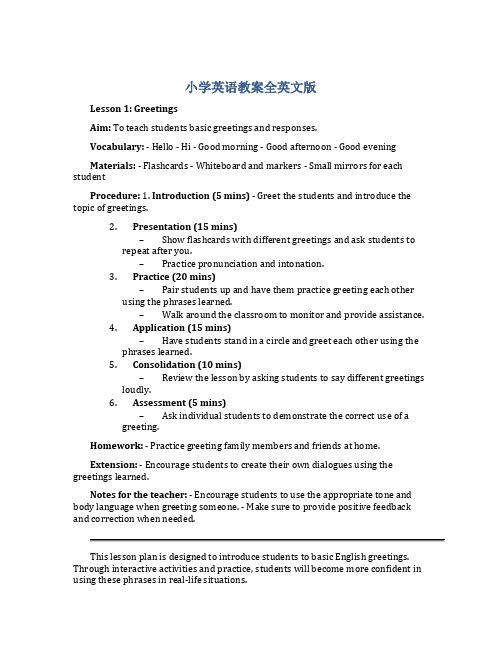
小学英语教案全英文版Lesson 1: GreetingsAim: To teach students basic greetings and responses.Vocabulary: - Hello - Hi - Good morning - Good afternoon - Good eveningMaterials: - Flashcards - Whiteboard and markers - Small mirrors for each studentProcedure: 1. Introduction (5 mins) - Greet the students and introduce the topic of greetings.2.Presentation (15 mins)–Show flashcards with different greetings and ask students to repeat after you.–Practice pronunciation and intonation.3.Practice (20 mins)–Pair students up and have them practice greeting each other using the phrases learned.–Walk around the classroom to monitor and provide assistance.4.Application (15 mins)–Have students stand in a circle and greet each other using the phrases learned.5.Consolidation (10 mins)–Review the lesson by asking students to say different greetings loudly.6.Assessment (5 mins)–Ask individual students to demonstrate the correct use of a greeting.Homework: - Practice greeting family members and friends at home.Extension: - Encourage students to create their own dialogues using the greetings learned.Notes for the teacher: - Encourage students to use the appropriate tone and body language when greeting someone. - Make sure to provide positive feedback and correction when needed.This lesson plan is designed to introduce students to basic English greetings. Through interactive activities and practice, students will become more confident in using these phrases in real-life situations.。
小学英语的全英文教案范文

小学英语全英文教案范文一、Lesson IntroductionObjective: To introduce oneself and ask questions about others. Materials: Flashcards of animalsProcedure:1. Greet the students and ask them to sit in a circle.2. Show the flashcards of animals one one and ask the students to repeat the name of the animal in English.3. Introduce yourself saying, "Hello, my name is [Your Name]. I am a teacher. What's your name?" Ask the students to introduce themselves.4. Practice asking and answering questions like, "How old are you?" and "Where are you from?"二、Lesson 2: Greetings and IntroductionsObjective: To learn how to greet and introduce oneself.Materials: Flashcards of greetings and introductionsProcedure:1. Start the class with a warm-up activity, such as singing a greeting song.2. Show the flashcards of greetings and introductions, such as "Hello," "Good morning," "Good afternoon," and "Goode." Ask the students to repeat after you.3. Practice asking and answering questions like, "How are you?" and "I'm fine, thank you."4. Introduce a new student to the class and ask the students to greet and introduce themselves.三、Lesson 3: ColorsObjective: To learn how to name and describe colors in English. Materials: Flashcards of colorsProcedure:1. Start the class showing a colorful picture or object and ask the students to name the colors.2. Show the flashcards of colors one one and ask the students to repeat the color name in English.3. Practice describing colors using phrases like, "It's blue," "It's a red car," and "The sky is blue."4. Draw a colorful picture with the students and ask them to name the colors as you draw.四、Lesson 4: Numbers 1-10Objective: To learn how to count from 1 to 10 in English.Materials: Number flashcards, objects to countProcedure:1. Start the class counting with the students, "One, two, three, four, five." Continue counting up to 10.2. Show the number flashcards one one and ask the students to repeat the number in English.3. Give the students a set of objects, such as counters or toys, and ask them to count the objects using English numbers.4. Play a number game, such as "Simon Says" or "Number Memory," to reinforce the counting skills.五、Lesson 5: AlphabetObjective: To learn the English alphabet and the sounds of each letter. Materials: Alphabet flashcards, letter sounds chartProcedure:1. Start the class singing the "Alphabet Song" to familiarize the students with the English alphabet.2. Show the alphabet flashcards one one and ask the students to repeat the letter name in English.3. Expln the sounds of each letter in the alphabet using a letter sounds chart.4. Practice tracing the letters of the alphabet on a large whiteboard or chart paper, and ask the students to follow along.六、Lesson 6: Family MembersObjective: To learn how to name family members in English. Materials: Flashcards of family membersProcedure:1. Start the class asking the students about their family members in their native language.2. Introduce the concept of family members in English showing the flashcards of family members, such as "mother," "father," "brother," "sister," and "grandparent."3. Practice asking and answering questions about family members, like "Who is your mother?" and "I have a sister."4. Ask the students to bring a picture of their family and describe their family members in English.七、Lesson 7: Dly RoutinesObjective: To learn how to describe dly routines in English. Materials: Flashcards of dly routinesProcedure:1. Start the class discussing the dly routines of the students in their native language.2. Introduce the concept of dly routines in English showing the flashcards of dly routines, such as "wake up," "eat breakfast," "go to school," and "play."3. Practice asking and answering questions about dly routines, like "What do you do in the morning?" and "What do you do after school?"4. Ask the students to role-play their dly routines using English words and phrases.八、Lesson 8: ClothingObjective: To learn how to name and describe different types of clothingin English.Materials: Flashcards of clothingProcedure:1. Start the class discussing the types of clothing worn in different seasons.2. Introduce the concept of clothing in English showing the flashcards of different types of clothing, such as "shirt," "pants," "dress," "sunglasses," and "hat."3. Practice asking and answering questions about clothing, like "What are you wearing today?" and "I am wearing a skirt."4. Ask the students to bring a picture of themselves in different types of clothing and describe their clothing in English.九、Lesson 9: Food and DrinksObjective: To learn how to name and describe different foods and drinks in English.Materials: Flashcards of food and drinksProcedure:1. Start the class discussing the types of food and drinks liked the students.2. Introduce the concept of food and drinks in English showing the flashcards of different food and drink items, such as "apple," "banana," "orange," "milk," and "water."3. Practice asking and answering questions about food and drinks, like "What is your favorite fruit?" and "Can I have some water, please?"4. Ask the students to bring a picture of their favorite food or drink and describe it in English.十、Lesson 10: Review and AssessmentObjective: To review the topics covered in the previous lessons and assess the students' understanding.Materials: Review worksheets, flashcardsProcedure:1. Start the class reviewing the topics covered in the previous lessons, such as greetings, introductions, colors, numbers, family members, dly routines, clothing, food and drinks.2. Conduct a mini-assessment to evaluate the students' understanding asking them to answer questions related to the topics.3. Use flashcards to test the students' vocabulary retention asking them to name the items in English.4. Provide review worksheets for the students to plete, which include exercises like fill in the blanks, match the words with their pictures, and write short sentences using the learned vocabulary.5. Give feedback to the students on their performance and encourage them to continue practicing their English skills.重点和难点解析一、Lesson Introduction重点关注环节:Students' ability to ask and answer questions about themselves.难点解析:This lesson introduces the concept of asking and answering questions about oneself, which is a fundamental skill in language learning. The students may find it challenging to express their personal information accurately and confidently in English.二、Lesson 2: Greetings and Introductions重点关注环节:Students' ability to use greetings and introduce themselves.难点解析:Using proper greetings and introductions is crucial in dly munication. The students might struggle with remembering and applying the correct phrases in different situations.三、Lesson 3: Colors重点关注环节:Students' ability to name and describe colors in English. 难点解析:Naming and describing colors can be challenging for students, especially those whose native language does not use the same color palette as English.四、Lesson 4: Numbers 1-10重点关注环节:Students' ability to count from 1 to 10 in English.难点解析:Counting is a foundational math skill that can be difficult for students to master when learning a new language, as it involvesunderstanding the numerical system and sequencing.五、Lesson 5: Alphabet重点关注环节:Students' ability to recognize and pronounce each letter of the English alphabet.难点解析:The English alphabet may have letters that are not present in the students' native language, making it challenging for them to recognize and pronounce them correctly.六、Lesson 6: Family Members重点关注环节:Students' ability to name family members in English and ask about others'.难点解析:Understanding and using family vocabulary can be emotional and personal for students. They may find it difficult to remember the English words for extended family members or to ask about others' families.七、Lesson 7: Dly Routines重点关注环节:Students' ability to describe their dly routines in English. 难点解析:Describing routines involves sequencing and using past tense verbs, which can be plex for beginners to grasp.八、Lesson 8: Clothing重点关注环节:Students' ability to name and describe different types of clothing in English.难点解析:Clothing terms can be abstract and may not have directtranslations in students' native languages. Additionally, students may be self-conscious about discussing their attire.九、Lesson 9: Food and Drinks重点关注环节:Students' ability to name and describe different foods and drinks in English.难点解析:Food and drink vocabulary can be extensive, and students may have difficulty remembering the names of specific items or describing preferences.十、Lesson 10: Review and Assessment重点关注环节:Students' ability to review and apply the knowledge gned from the previous lessons.难点解析:Assessment can be stressful for students, especially if they feel unprepared. Ensuring that the review is prehensive and allows for individualized learning is crucial.这些教案环节涵盖了从自我介绍到日常生活中的各种主题,每个环节都有其特定的重点和难点。
英语教案范文全英文版小学英语教案范文

小学英语教案范文一、教学目标1. 知识目标:学生能够掌握基本的英语问候语和自我介绍的表达方式。
学生能够理解和使用简单的英语指令和问题。
2. 技能目标:学生能够听懂并能够用英语进行简单的问候和自我介绍。
学生能够用英语进行简单的日常交流和表达需求。
3. 情感目标:培养学生的学习兴趣和积极性,增强他们对英语的亲近感。
培养学生的团队合作意识和沟通能力。
二、教学内容1. 主题:基本的英语问候语和自我介绍2. 语言点:问候语:Good morning, good afternoon, good evening, hello, how are you?自我介绍:My name is, I am from, I am in grade.三、教学方法1. 交际法:通过模拟真实情境,让学生在实际交流中学习和使用英语。
2. 任务型教学法:通过完成具体的任务,让学生在实践中运用英语。
3. 小组合作学习:通过小组活动,培养学生的团队合作意识和沟通能力。
四、教学步骤1. 导入:教师用中文向学生问好,并引入英语问候语的学习。
2. 新课内容:教师用英语教授基本的问候语和自我介绍的表达方式。
3. 实践环节:学生分组进行角色扮演,模拟真实情境,用英语进行问候和自我介绍。
4. 巩固环节:教师组织学生进行小组活动,完成相关的任务,如制作自我介绍海报等。
五、作业布置1. 学生回家后,用英语向家人进行自我介绍。
2. 学生准备一首简单的英语歌曲,下节课向全班同学展示。
六、教学评估1. 课堂参与度:观察学生在课堂上的参与情况,包括发言、互动和小组活动。
2. 语言准确性:评估学生在使用英语时的准确性,包括语法、词汇和发音。
3. 任务完成情况:检查学生完成任务的情况,包括自我介绍海报的制作和英语歌曲的展示。
七、教学拓展1. 邀请英语母语的志愿者来课堂进行交流,让学生有机会与外国人实践英语。
2. 组织英语角活动,让学生在轻松的氛围中练习英语口语。
3. 推荐学生参加英语演讲比赛或英语角比赛,提高他们的英语表达能力。
小学英语说课稿全英文
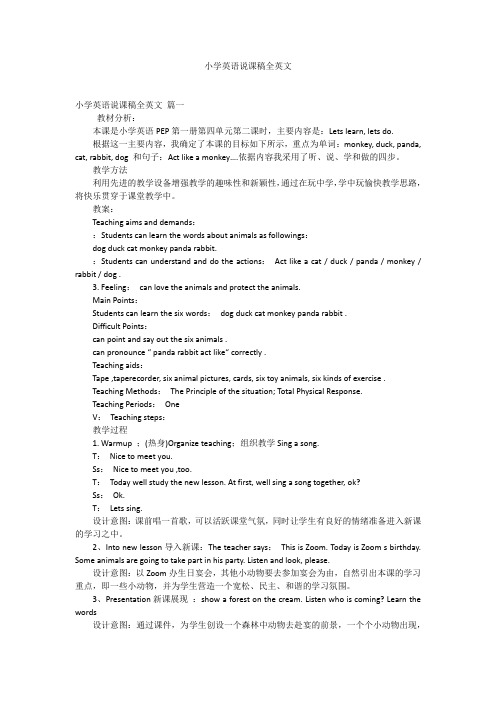
小学英语说课稿全英文小学英语说课稿全英文篇一教材分析:本课是小学英语PEP第一册第四单元第二课时,主要内容是:Lets learn, lets do.根据这一主要内容,我确定了本课的目标如下所示,重点为单词:monkey, duck, panda, cat, rabbit, dog 和句子:Act like a monkey….依据内容我采用了听、说、学和做的四步。
教学方法利用先进的教学设备增强教学的趣味性和新颖性,通过在玩中学,学中玩愉快教学思路,将快乐贯穿于课堂教学中。
教案:Teaching aims and demands::Students can learn the words about animals as followings:dog duck cat monkey panda rabbit.:Students can understand and do the actions:Act like a cat / duck / panda / monkey / rabbit / dog .3. Feeling:can love the animals and protect the animals.Main Points:Students can learn the six words:dog duck cat monkey panda rabbit .Difficult Points:can point and say out the six animals .can pronounce “ panda rabbit act like“ correctly .Teaching aids:Tape ,taperecorder, six animal pictures, cards, six toy animals, six kinds of exercise .Teaching Methods:The Principle of the situation; Total Physical Response.Teaching Periods:OneV:Teaching steps:教学过程1. Warmup ;(热身)Organize teaching;组织教学Sing a song.T:Nice to meet you.Ss:Nice to meet you ,too.T:Today well study the new lesson. At first, well sing a song together, ok?Ss:Ok.T:Lets sing.设计意图:课前唱一首歌,可以活跃课堂气氛,同时让学生有良好的情绪准备进入新课的学习之中。
小学英语教案设计模板全英文

Subject: EnglishGrade Level: [Grade Level]Class Duration: [Duration in minutes]Objective(s):1. To teach [specific language objective(s)].2. To develop [specific skills, such as reading, writing, speaking, or listening].3. To foster [specific cultural or social skills, such as teamwork or understanding of diversity].Materials Needed:- Whiteboard and markers- Handouts or worksheets- Audio-visual aids (e.g., flashcards, pictures, videos)- Computers or tablets with internet access (if needed)- Resources for assessment (e.g., quizzes, tests, portfolios)Preparation:1. Review the course objectives and standards to ensure alignment with the lesson plan.2. Prepare all necessary materials and resources in advance.3. Familiarize yourself with the content and any potential challenges for students.4. Plan for differentiation to meet the needs of diverse learners.Introduction (5 minutes):1. Greet students and check for attendance.2. Review the lesson objectives and any key vocabulary or concepts.3. Engage students with a relevant hook or activity to capture their interest.Warm-Up Activity (5 minutes):1. Conduct a brief review of previous lessons or vocabulary.2. Use a fun and interactive activity to activate prior knowledge and get students thinking in English.- Example: Quick vocabulary review game using flashcards or a "Simon Says" variation.Main Activity (20-25 minutes):1. Introduce the new language objective(s) through a clear and engaging presentation.- Example: Use a story, song, or a demonstration to introduce new vocabulary or grammar structures.2. Provide examples and practice activities to reinforce the new content.- Example: Pair work activities, group discussions, or interactive whiteboard activities.3. Implement a variety of teaching strategies to cater to different learning styles.- Example: Visuals, auditory aids, kinesthetic activities, and collaborative learning.Assessment (10-15 minutes):1. Assess students' understanding and progress through formative assessment techniques.- Example: Quizzes, oral questions, short written tasks, or peer assessment.2. Provide immediate feedback to students to help them correct errors and improve their skills.Conclusion (5-10 minutes):1. Summarize the key points covered in the lesson.2. Review any homework or additional resources for further practice.3. Engage students in an exit ticket activity to reinforce learning.- Example: Write a sentence using the new vocabulary, draw a picture related to the lesson, or discuss their favorite part of the lesson.Homework Assignment:1. Assign relevant homework that reinforces the lesson objectives.2. Ensure that the homework is appropriate for the grade level and meets the needs of all students.Reflection and Assessment:1. Reflect on the effectiveness of the lesson in achieving the objectives.2. Assess the learning outcomes of the students and adjust future lesson plans accordingly.3. Consider any challenges encountered and strategies for overcoming them in future lessons.Note:- This template is designed to be flexible and can be adapted to various teaching contexts and student needs.- It is important to continuously assess and modify the lesson plan based on student feedback and performance.---This template provides a comprehensive structure for designing an English lesson plan for primary school students. It ensures that the lesson is well-organized, purposeful, and engaging, with clear objectives and a variety of teaching and assessment strategies.。
英语教案模板小学全英文
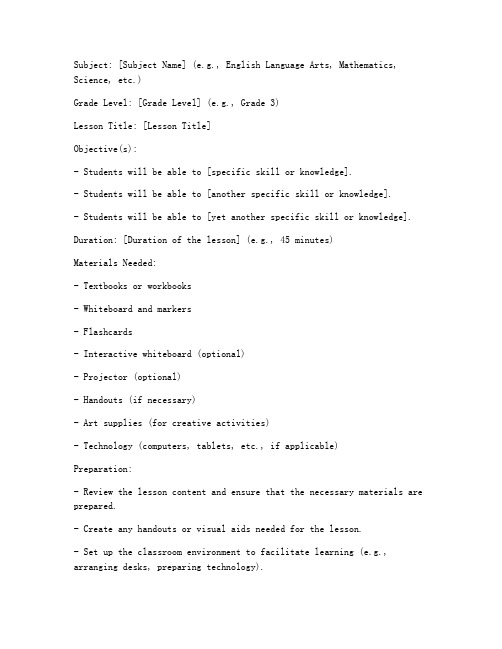
Subject: [Subject Name] (e.g., English Language Arts, Mathematics, Science, etc.)Grade Level: [Grade Level] (e.g., Grade 3)Lesson Title: [Lesson Title]Objective(s):- Students will be able to [specific skill or knowledge].- Students will be able to [another specific skill or knowledge].- Students will be able to [yet another specific skill or knowledge].Duration: [Duration of the lesson] (e.g., 45 minutes)Materials Needed:- Textbooks or workbooks- Whiteboard and markers- Flashcards- Interactive whiteboard (optional)- Projector (optional)- Handouts (if necessary)- Art supplies (for creative activities)- Technology (computers, tablets, etc., if applicable)Preparation:- Review the lesson content and ensure that the necessary materials are prepared.- Create any handouts or visual aids needed for the lesson.- Set up the classroom environment to facilitate learning (e.g., arranging desks, preparing technology).Warm-Up (5 minutes):- Start the lesson with a short activity to engage students' attention and review previous learning.- Example: A quick review game using flashcards or a quick quiz on the previous lesson's vocabulary.Introduction (5 minutes):- Introduce the lesson topic and objectives clearly.- Example: "Today, we are going to learn about [topic]. By the end of the lesson, you will be able to [list objectives]."Main Activity (20-30 minutes):- Present new content through various teaching methods.- Example:- Use a story to introduce new vocabulary.- Conduct a group activity where students work together to solve a problem.- Use an interactive whiteboard to present key concepts and engage students in interactive discussions.Guided Practice (10-15 minutes):- Provide students with guided practice to reinforce the new skills or knowledge.- Example:- Pair students up and have them practice reading a passage aloud to each other.- Conduct a mini-lesson on grammar rules and then have students complete a related worksheet.Independent Practice (10-15 minutes):- Allow students to practice independently, applying what they have learned.- Example:- Give students a worksheet with exercises related to the lesson.- Assign a writing task where students can demonstrate their understanding of the topic.Assessment (5 minutes):- Assess students' understanding of the lesson content.- Example:- Quick write: Students write a short paragraph summarizing what they learned.- Exit ticket: Students complete a quick question or task as they leave the classroom.Closing (5 minutes):- Summarize the key points of the lesson.- Example: "Today, we learned about [topic]. Remember, [key takeaways]. Let's review the vocabulary we learned today."Homework (if applicable):- Assign relevant homework to reinforce learning.- Example: "For homework, please read the next chapter in our textbook and write a short summary."Reflection and Feedback:- After the lesson, reflect on what went well and what could be improved.- Seek feedback from students to understand their learning experience and make necessary adjustments for future lessons.Note:- Adjust the lesson plan as needed based on the students' needs, learning styles, and classroom dynamics.- Be flexible and responsive to student feedback and engagement throughout the lesson.。
小学英语全英教案万能模板
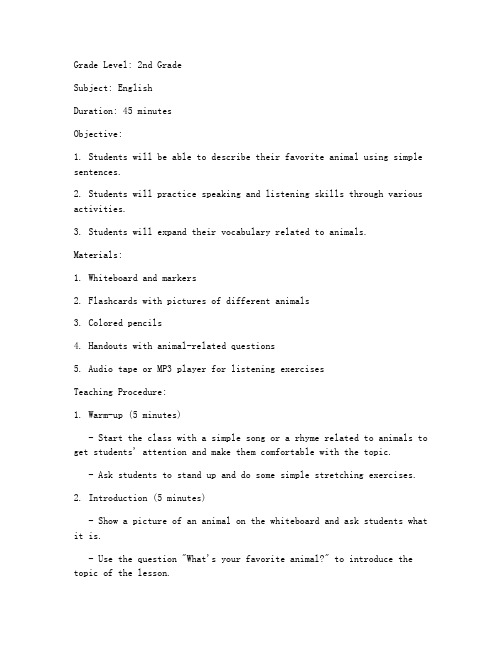
Grade Level: 2nd GradeSubject: EnglishDuration: 45 minutesObjective:1. Students will be able to describe their favorite animal using simple sentences.2. Students will practice speaking and listening skills through various activities.3. Students will expand their vocabulary related to animals.Materials:1. Whiteboard and markers2. Flashcards with pictures of different animals3. Colored pencils4. Handouts with animal-related questions5. Audio tape or MP3 player for listening exercisesTeaching Procedure:1. Warm-up (5 minutes)- Start the class with a simple song or a rhyme related to animals to get students' attention and make them comfortable with the topic.- Ask students to stand up and do some simple stretching exercises.2. Introduction (5 minutes)- Show a picture of an animal on the whiteboard and ask students what it is.- Use the question "What's your favorite animal?" to introduce the topic of the lesson.- Explain that today's class will be about describing their favorite animal.3. Vocabulary Building (10 minutes)- Hand out flashcards with pictures of different animals to each student.- Ask students to name the animals and write down any new vocabulary they learn.- Use the phrase "I like..." to introduce the animals and their names.4. Listening Exercise (5 minutes)- Play a short audio clip with animal sounds or a story about animals.- Ask students to listen carefully and answer questions related to the listening material.- Questions can include: What animal is making the sound? What is happening in the story?5. Speaking Activity (10 minutes)- Divide the class into small groups of 3-4 students.- Each group will choose one animal from the flashcards and discuss their favorite animal in English.- Encourage students to use new vocabulary and simple sentences to describe their animal.- Rotate groups and provide feedback on their speaking skills.6. Writing Activity (10 minutes)- Give each student a handout with animal-related questions, such as:- What is your favorite animal?- Why do you like it?- What does it look like?- What does it do?- Ask students to write a short paragraph about their favorite animal using the questions as a guide.- Encourage students to draw a picture of their animal to accompany their writing.7. Review and Conclusion (5 minutes)- Have a class discussion about the favorite animals that students mentioned.- Ask students to share their writing and pictures with the class.- Review the new vocabulary and correct any mistakes made during the speaking and writing activities.Homework:1. Students should bring a picture of their favorite animal to class next time.2. Practice using the new vocabulary and sentences at home.Assessment:- Observe students' participation and engagement during the activities.- Assess the quality of students' writing and speaking skills based on their responses and performance in class.- Evaluate the understanding of new vocabulary through quizzes or games.。
小学英语教案模板英文版

小学英语教案模板英文版教案小学英语教案模板英文版教学目标:1. 学生能够掌握本节课所学的单词和句型。
2. 学生能够运用所学单词和句型进行简单的对话。
3. 学生能够通过活动提高英语听、说、读、写能力。
教学重点:1. 掌握单词:apple, banana, orange, pear, grape2. 掌握句型:What’s this? It’s an apple. I like apples.教学难点:1. 学会正确发音和拼写单词。
2. 学会运用句型进行对话。
教学准备:1. 单词卡片:apple, banana, orange, pear, grape2. 图片:apple, banana, orange, pear, grape3. 教学课件教学过程:一、热身活动(5分钟)1. 歌曲导入:播放一首关于水果的歌曲,如《Fruit Salad》。
2. 舞蹈动作:引导学生跟随歌曲做简单的舞蹈动作,活跃课堂气氛。
二、新授环节(15分钟)1. 教师展示单词卡片,带领学生跟读单词:apple, banana, orange, pear, grape。
2. 教师展示图片,引导学生说出对应的单词。
3. 教师教授句型:What’s this? It’s an apple. I like apples。
4. 学生跟读句型,教师纠正发音。
三、互动环节(15分钟)1. 小组活动:将学生分成若干小组,每组发放一套单词卡片和图片。
2. 学生在小组内进行对话练习,一人问:“What’s this?”,另一人回答:“It’s an apple. I like apples.”。
3. 教师巡视,纠正发音和句型错误。
四、游戏环节(10分钟)1. 猜水果游戏:教师将水果图片贴在黑板上,让学生闭上眼睛,随机拿掉一张图片,学生猜猜哪个水果被拿掉了。
2. 学生回答:“I think it’s anapple/banana/orange/pear/grape.”3. 教师揭示答案,并给予鼓励和表扬。
小学英语教案模板范文全英文版
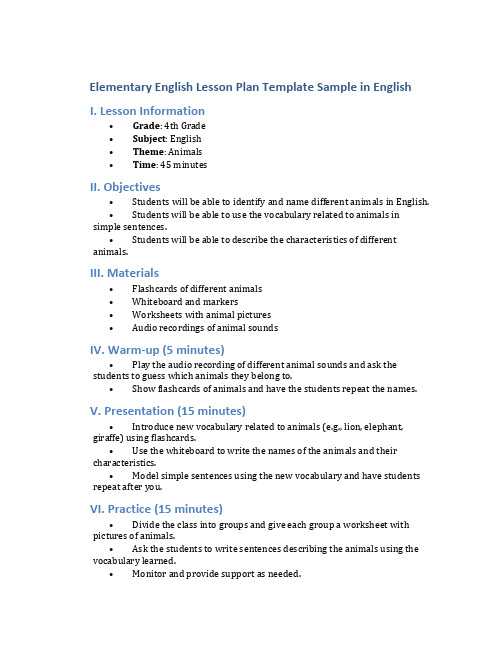
Elementary English Lesson Plan Template Sample in English I. Lesson Information•Grade: 4th Grade•Subject: English•Theme: Animals•Time: 45 minutesII. Objectives•Students will be able to identify and name different animals in English.•Students will be able to use the vocabulary related to animals in simple sentences.•Students will be able to describe the characteristics of different animals.III. Materials•Flashcards of different animals•Whiteboard and markers•Worksheets with animal pictures•Audio recordings of animal soundsIV. Warm-up (5 minutes)•Play the audio recording of different animal sounds and ask the students to guess which animals they belong to.•Show flashcards of animals and have the students repeat the names. V. Presentation (15 minutes)•Introduce new vocabulary related to animals (e.g., lion, elephant, giraffe) using flashcards.•Use the whiteboard to write the names of the animals and their characteristics.•Model simple sentences using the new vocabulary and have students repeat after you.VI. Practice (15 minutes)•Divide the class into groups and give each group a worksheet with pictures of animals.•Ask the students to write sentences describing the animals using the vocabulary learned.•Monitor and provide support as needed.VII. Production (10 minutes)•Have students present their sentences to the class.•Encourage peer feedback and corrections.•Play a game where students act out different animals and their characteristics for the class to guess.VIII. Review and Assessment (5 minutes)•Review the vocabulary and key sentences learned during the lesson.•Ask students to name different animals and describe their features.•Provide positive feedback and praise for their effort.IX. Homework•Assign homework that involves practicing the vocabulary and sentences related to animals.•Encourage students to read a short story about animals in English.X. Extension Activities•Create a class mural with drawings of different animals and their names.•Watch a short video or listen to a song about animals for fun.This lesson plan is designed to engage young learners in exploring the world of animals through vocabulary, sentences, and interactive activities. By the end of the lesson, students will have a better understanding of different animals and how to talk about them in English.。
小学英语全英教案【通用6篇】
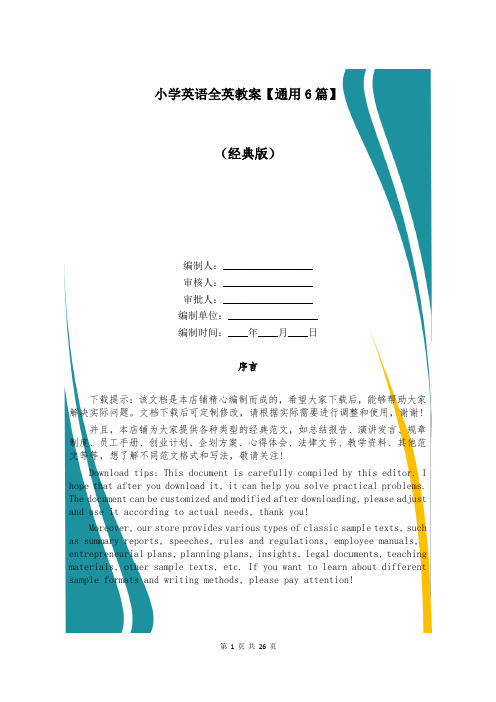
小学英语全英教案【通用6篇】(经典版)编制人:__________________审核人:__________________审批人:__________________编制单位:__________________编制时间:____年____月____日序言下载提示:该文档是本店铺精心编制而成的,希望大家下载后,能够帮助大家解决实际问题。
文档下载后可定制修改,请根据实际需要进行调整和使用,谢谢!并且,本店铺为大家提供各种类型的经典范文,如总结报告、演讲发言、规章制度、员工手册、创业计划、企划方案、心得体会、法律文书、教学资料、其他范文等等,想了解不同范文格式和写法,敬请关注!Download tips: This document is carefully compiled by this editor. I hope that after you download it, it can help you solve practical problems. The document can be customized and modified after downloading, please adjust and use it according to actual needs, thank you!Moreover, our store provides various types of classic sample texts, such as summary reports, speeches, rules and regulations, employee manuals, entrepreneurial plans, planning plans, insights, legal documents, teaching materials, other sample texts, etc. If you want to learn about different sample formats and writing methods, please pay attention!小学英语全英教案【通用6篇】小学英语全英教案篇一Section CCould you give us some advice on how to learn English well? 公安县自强初级中学杜亚兰Ⅰ.Material analysis 本课是九年级第三单元第三话题的第三课时。
小学英语教案全英文模板

Subject: English Language ArtsGrade Level: [e.g., 3rd Grade]Lesson Title: [e.g., "My Favourite Food"]Objective(s):- Students will be able to describe their favorite food using simple sentences.- Students will practice using new vocabulary related to food and taste.- Students will engage in listening, speaking, reading, and writing activities to reinforce their understanding of the topic.Duration: [e.g., 45 minutes]Materials Needed:- Whiteboard or blackboard- Markers or chalk- Flashcards with pictures of different foods- Textbooks or handouts- Activity sheets- Pencils, crayons, or colored pencils- CDs or mp3 players (optional)Preparation:- Prepare the whiteboard with a simple agenda and key vocabulary.- Make or collect flashcards with pictures of various foods.- Prepare activity sheets with exercises related to the lesson topic.- Familiarize yourself with the songs or stories that will be used for the lesson (if applicable).Warm-Up (5 minutes):- Begin the class with a simple greeting and a review of the previous lesson.- Ask students to share something they learned or a question they have about the previous topic.Introduction (10 minutes):- Introduce the new topic by showing a picture of the food that will be the focus of the lesson.- Use the flashcards to present new vocabulary related to the food, such as "apple," "banana," "tasty," and "yummy."- Write the key vocabulary on the board and ask students to repeat it.Presentation (15 minutes):- Use a story or song related to the topic to introduce the language in a fun and engaging way.- If using a song, play it once for the class to listen and follow along.- After the first listening, pause the song and ask students to repeat the lyrics or phrases.- Discuss the story or song with the class, asking questions to checkfor understanding.Practice (15 minutes):- Divide the class into small groups and give each group an activity sheet with exercises related to the topic.- Encourage students to work together to complete the exercises.- Circulate around the room to provide assistance and monitor progress.Speaking Activity (10 minutes):- Have students create sentences about their favorite food using the new vocabulary.- Pair students up and have them practice telling each other about their favorite food.- Rotate partners to ensure that all students have an opportunity to speak.Writing Activity (10 minutes):- Ask students to write a short paragraph describing their favorite food.- Provide a template or a sentence starter to help them get started.- Circulate around the room to provide feedback and encourage students to use the new vocabulary.Cool Down (5 minutes):- Conclude the lesson with a quick review of the new vocabulary.- Have students draw a picture of their favorite food and label it with the new words.- Ask for volunteers to share their drawings and sentences with the class.Assessment:- Evaluate students' participation and engagement during the lesson.- Assess the accuracy and fluency of their spoken and written responses.- Check the completed activity sheets and writing tasks for understanding and application of the new vocabulary.Follow-Up Activities:- Assign a homework task to reinforce the lesson, such as drawing a family meal and labeling the foods.- Plan for the next lesson to build upon the new vocabulary and concepts introduced in this lesson.Reflection:- After the lesson, reflect on what worked well and what could be improved.- Consider how the lesson objectives were met and how students engaged with the material.- Plan for adjustments in future lessons to enhance student learning and participation.。
小学英语全英教案模板-小学全英文教案模板
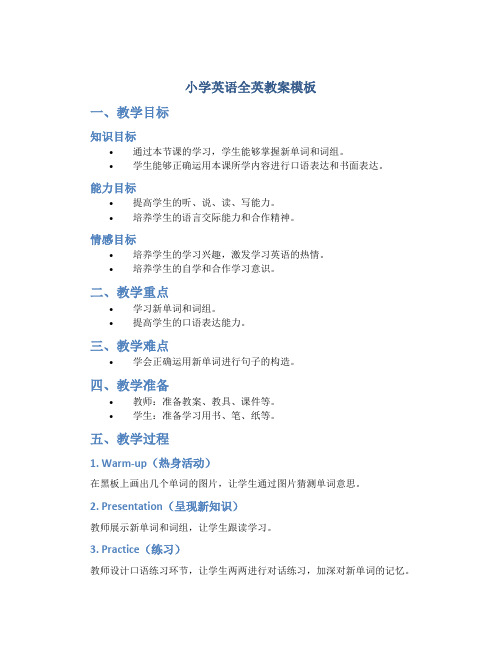
小学英语全英教案模板
一、教学目标
知识目标
•通过本节课的学习,学生能够掌握新单词和词组。
•学生能够正确运用本课所学内容进行口语表达和书面表达。
能力目标
•提高学生的听、说、读、写能力。
•培养学生的语言交际能力和合作精神。
情感目标
•培养学生的学习兴趣,激发学习英语的热情。
•培养学生的自学和合作学习意识。
二、教学重点
•学习新单词和词组。
•提高学生的口语表达能力。
三、教学难点
•学会正确运用新单词进行句子的构造。
四、教学准备
•教师:准备教案、教具、课件等。
•学生:准备学习用书、笔、纸等。
五、教学过程
1. Warm-up(热身活动)
在黑板上画出几个单词的图片,让学生通过图片猜测单词意思。
2. Presentation(呈现新知识)
教师展示新单词和词组,让学生跟读学习。
3. Practice(练习)
教师设计口语练习环节,让学生两两进行对话练习,加深对新单词的记忆。
4. Production(表达)
要求学生运用新学的单词和词组进行句子编写,展示个人观点。
5. Homework(作业布置)
布置相关作业,巩固所学内容。
六、教学反思
经过本节课的教学,学生对新单词的掌握情况如何?口语表达能力有所提高吗?如何改进教学方式提高学生的学习兴趣?
这份全英文教案模板力求通过多种学习方式和环节的设计,引导学生在轻松愉
悦的氛围中学习英语,培养其语言交际能力和合作精神,为日后的学习打下坚实的基础。
小学英语教案全英文版模板范文
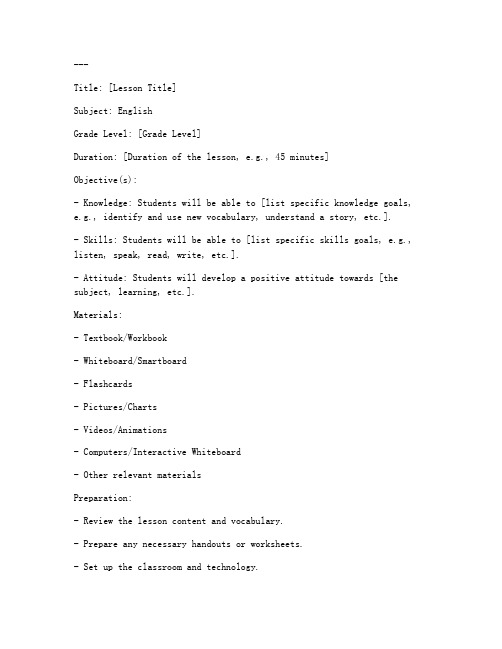
---Title: [Lesson Title]Subject: EnglishGrade Level: [Grade Level]Duration: [Duration of the lesson, e.g., 45 minutes]Objective(s):- Knowledge: Students will be able to [list specific knowledge goals, e.g., identify and use new vocabulary, understand a story, etc.].- Skills: Students will be able to [list specific skills goals, e.g., listen, speak, read, write, etc.].- Attitude: Students will develop a positive attitude towards [the subject, learning, etc.].Materials:- Textbook/Workbook- Whiteboard/Smartboard- Flashcards- Pictures/Charts- Videos/Animations- Computers/Interactive Whiteboard- Other relevant materialsPreparation:- Review the lesson content and vocabulary.- Prepare any necessary handouts or worksheets.- Set up the classroom and technology.- Arrange the seating for group work or partner activities.---Introduction (5 minutes)1. Greeting and Warm-Up:- Greet students and check their attendance.- Engage students with a quick warm-up activity, such as a song or a game related to the theme of the lesson.2. Review of Previous Lesson:- Briefly review the main points from the previous lesson to activate prior knowledge.3. Presentation of New Material:- Introduce the new vocabulary or concepts using visuals, realia, or TPR (Total Physical Response) activities.---Main Activity (20 minutes)1. Listening Activity:- Play a video or audio clip related to the theme.- Ask students to listen and answer comprehension questions.- Discuss the content and vocabulary used in the clip.2. Speaking Activity:- Engage students in a conversation or role-play activity using the new vocabulary.- Pair students up or form small groups for group discussions or activities.3. Reading Activity:- Introduce a short story, poem, or passage related to the theme.- Have students read the text individually or in pairs.- Discuss the content and ask comprehension questions.4. Writing Activity:- Assign a writing task that requires students to use the new vocabulary or concepts.- Provide a model or guidelines to help students complete the task.---Practice (10 minutes)1. Practice Activities:- Provide additional practice opportunities for the new vocabulary and concepts.- Use activities such as word searches, crossword puzzles, or matching exercises.2. Group Work:- Assign a group activity that allows students to apply their knowledge in a collaborative setting.---Conclusion (5 minutes)1. Summary:- Summarize the main points of the lesson and review the new vocabulary or concepts.2. Homework Assignment:- Assign homework that reinforces the learning objectives, such as completing a worksheet, writing a short story, or practicing new vocabulary.3. Feedback:- Provide positive feedback and encourage students for their participation and effort.---Assessment:- Formative Assessment: Observations, participation, and responses during the lesson.- Summative Assessment: Homework assignments, quizzes, or tests.---Reflection:- After the lesson, reflect on what worked well and what could be improved for future lessons.- Consider student feedback and adjust the teaching methods or materials as needed.。
小学英语全英文教案范文全英版

小学英语全英文教案范文全英版你们觉得小学英语老师在备案时,用的全中文还是全英文?下面是带来小学英语全英文教案设计范文,希望对大家有帮助。
小学英语全英文教案范文篇1Unit 1 Lesson 3Part A Let’s say, Let’s chant Part C CultureTeaching Aims :1. Be able to listen, say, recognize the words: apple, ant,boy, bag, Coke, coffee.2. Be able to listen, say, read and write these three letters:A a;B b;C c3. Through the chant review the letters of ABC, train a sense of group identity.Focus Points & Difficult Points :Read the letters: Big letter C, small letter c; Write down them correctly and handsomely.Teaching Preparation:1. Letter cards ,some word pictures, word cards: apple boyeraser ant crayon body head cake Coke coffee bag ball2. A little blackboard with four-line format and a ball.Designing for the blackboard:panda beaver eagle kangaroo (pictures)China Canada America Australia (words)Teaching Steps:Step1. Warm –up4. Sing a song.5. Free talkT: Hello. I’m Wendy. I’m from Hangzhou.S1: Hello! I’m ... I’m from Hangzhou,too.T: Nice to meet you.S: Nice to meet you, too.T: Let’s play. Ok?S: Great!T: Watch out! (T throws the ball.)S: Oh, no.Make a similar dialogue with your partner.Step2.Presentation.3. 1)T : Today, we will learn letters. Do you know letters?Just as A,B,C…… They are letters. What’s the meaning of letters?S: 字母。
小学英语教案万能模板全英

小学英语教案万能模板全英
第一部分:教学目标
•知识目标:掌握单词的拼读和基本意义。
•能力目标:能用简单的语句介绍自己。
•情感目标:培养学生积极参与英语学习的兴趣。
第二部分:教学准备
•教材准备:教科书、录音设备、课件。
•教具准备:黑板、彩色粉笔、图片卡片。
第三部分:教学过程
一、热身
1.复习上节课所学内容,引导学生进入英语学习状态。
2.通过唱歌、游戏等形式进行热身活动。
二、新课导入
1.准备图片卡片,引导学生猜测单词。
2.呈现新单词,并教授单词的拼读和意义。
三、学习活动
1.听录音,模仿发音,培养学生的听力和口语表达能力。
2.分组进行口语对话练习,让学生能够运用所学内容进行交流。
四、巩固练习
1.完成练习册上的练习题,巩固学习内容。
2.创设情景,让学生运用所学内容进行情景表演。
五、拓展延伸
1.引导学生自主学习,通过互动游戏等形式,加深对知识的理解。
2.带领学生欣赏英语歌曲、短片等,培养学生对英语的兴趣。
第四部分:课堂小结
•回顾本节课的重点内容,激励学生学习英语的积极性。
•提醒学生完成作业,准备好下节课的学习内容。
第五部分:作业布置
•完成课后练习册上指定的练习题,并背诵新学的单词。
第六部分:教学反思
•总结本节课的教学过程,反思教学中存在的问题并尝试改进。
通过以上教学模板,我们可以有效地指导小学生学习英语,激发他们对英语学习的兴趣,提高他们的语言表达能力。
希望本节课的设计能够对教师在小学英语教学中提供一定的帮助和启发。
小学英语教案模板5篇

小学英语教案模板5篇学校英语教案模板篇1教学内容:Part B and D of Unit 11 A boy and a girl, Fun with English.教学目标:1、 Enable the Ss to understand, read and say the new words “boy, girl, Chinese, thin, fat, tall, short.”2、 Enable the Ss to use the sentence in their daily life.3、Develop the Ss' abilities of listening, speaking, and writing English.4、 Train the Ss' abilities of cooperation.重点难点:1、 The pronunciation of some new words “girl, thin, tall, small”2、 Enable the Ss to say and use the sentences“My name is …I'm …”to introduce themselves to others.教学预备:CAI、tape、recorder.教学方法:Communicational Approach教学过程:Step1、 Warm—up1、 Sing a song “Hello”。
2、 Free talkT: This is … Her name is Helen.What's your name? Nice to meet you.Step2、 Presentation & practice1、 Present and practice the new sentence “My name is …”2 T: Do you want to know my name?Ss: …T: My name is …(T presents the new sentence “My name is …”)T: My name is Zhu Xiaoyan. How about your name?S: My name is ……2、 Present and practice the new words “boy, girl, Chinese, I'm from…”T: (Show the Ss the picture of Liu Tao) Look, this is …Ss: Liu Tao. T: This is Liu Tao. So we know his name is Liu Tao.T: How about his sex?T: What's this?T: This is a Chinese flag. (Present and teach the word “boy, Chinese”)T: (point to one of them) this is a … Liu Tao is a Chinese boy.How about...? T: (point to one of them)… is a …T: Who's she? (Present the new word “girl”)T: Miss Zhu is a girl. I'm a Chinese girl. And I'm from Rudong.T: Where are you from? …(Present the sentence “I'm from…”)Do you know where is Liu Tao from?3、Present and practice the new words “fat, thin, tall, short”T: We know Liu Tao is from Shanghai. Shanghai is a beautiful city. Let's go to Shanghai.Ss: OK. T: Where is it?Ss: It's a zoo.T: Let's see what are in the zoo. (Present some pictures of animals)T: Look, this is a …(monkey) And this is a monkey. (Present and practice the word “fat, thin”)T: (Present the picture of LiuTao and Yao Ming) This is .T: Yao Ming is . (Present and practice the new word “tall, short”)4、 Present and read the textT: Now, how much do you know about Liu Tao? Say it out! …T: Let's read and learn Liu Tao's self-introduction.(Ask the Ss to read after the tape )T: Close your books, please. Look , This is Liu Tao's self-introduction, and this is me, can you help me correct it? (Ask the Ss to correct the self-introduction, and learn the example.)Step3、ConsolidationT: Now, boys and girls.Try to introduce yourselves.You have 30 seconds to do it.Step4、 Homework1、 Make your self-introduction card.2、 Introduce yourselves to five people and ask them to sign on the back of your introduction cards.板书设计:Unit 11 A boy and a girlMy name is … I'm aChinese… boy girl I'm from…I'm …(年龄) tall shortI'm …(特征) fat thin学校英语教案模板篇2一、教学内容1.词汇(略)。
小学英语教案全英文版【三篇】
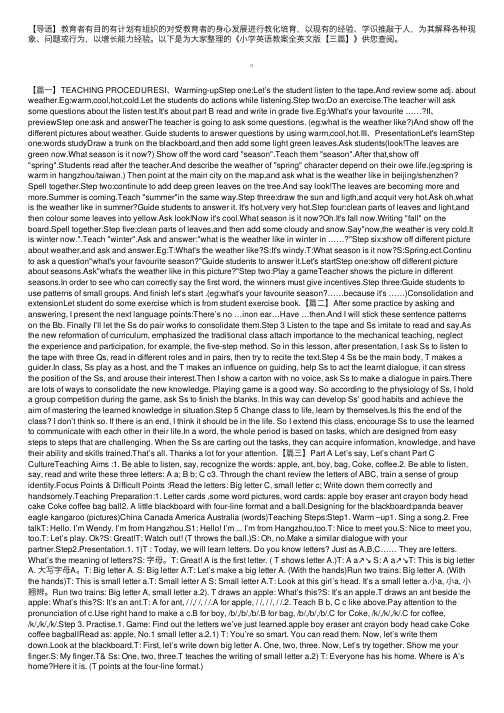
【导语】教育者有⽬的有计划有组织的对受教育者的⾝⼼发展进⾏教化培育,以现有的经验、学识推敲于⼈,为其解释各种现象、问题或⾏为,以增长能⼒经验。
以下是为⼤家整理的《⼩学英语教案全英⽂版【三篇】》供您查阅。
【篇⼀】TEACHING PROCEDURESI、Warming-upStep one:Let’s the student listen to the tape.And review some adj. about weather.Eg:warm,cool,hot,cold.Let the students do actions while listening.Step two:Do an exercise.The teacher will ask some questions about the listen test.It's about part B read and write in grade five.Eg:What's your favourite (II)previewStep one:ask and answerThe teacher is going to ask some questions. (eg:what is the weather like?)And show off the different pictures about weather. Guide students to answer questions by using warm,cool,hot.III、PresentationLet's learnStep one:words studyDraw a trunk on the blackboard,and then add some light green leaves.Ask students(look!The leaves are green now.What season is it now?) Show off the word card "season".Teach them "season".After that,show off "spring".Students read after the teacher.And describe the weather of "spring" character depend on their owe life.(eg:spring is warm in hangzhou/taiwan.) Then point at the main city on the map,and ask what is the weather like in beijing/shenzhen? Spell together.Step two:continute to add deep green leaves on the tree.And say look!The leaves are becoming more and more.Summer is coming.Teach "summer"in the same way.Step three:draw the sun and ligth,and acquit very hot.Ask oh,what is the weather like in summer?Guide students to answer it. It's hot,very very hot.Step four:clean parts of leaves and light,and then colour some leaves into yellow.Ask look!Now it's cool.What season is it now?Oh.It's fall now.Writing "fall" on the board.Spell together.Step five:clean parts of leaves,and then add some cloudy and snow.Say"now,the weather is very cold.It is winter now.".Teach "winter".Ask and answer:"what is the weather like in winter in ……?"Step six:show off different picture about weather,and ask and answer.Eg:T:What's the weather like?S:It's windy.T:What season is it now?S:Spring.ect.Continu to ask a question"what's your favourite season?"Guide students to answer it.Let's startStep one:show off different picture about seasons.Ask"what's the weather like in this picture?"Step two:Play a gameTeacher shows the picture in different seasons.In order to see who can correctly say the first word, the winners must give incentives.Step three:Guide students to use patterns of small groups. And finish let's start .(eg:what's your favourite season?……because it's ……)Consolidation and extensionLet student do some exercise which is from student exercise book.【篇⼆】After some practice by asking and answering, I present the next language points:There’s no …inon ear…Have …then.And I will stick these sentence patterns on the Bb. Finally I’ll let the Ss do pair works to consolidate them.Step 3 Listen to the tape and Ss imitate to read and say.As the new reformation of curriculum, emphasized the traditional class attach importance to the mechanical teaching, neglect the experience and participation, for example, the five-step method. So in this lesson, after presentation, I ask Ss to listen to the tape with three Qs, read in different roles and in pairs, then try to recite the text.Step 4 Ss be the main body, T makes a guider.In class, Ss play as a host, and the T makes an influence on guiding, help Ss to act the learnt dialogue, it can stress the position of the Ss, and arouse their interest.Then I show a carton with no voice, ask Ss to make a dialogue in pairs.There are lots of ways to consolidate the new knowledge. Playing game is a good way. So according to the physiology of Ss, I hold a group competition during the game, ask Ss to finish the blanks. In this way can develop Ss’ good habits and achieve the aim of mastering the learned knowledge in situation.Step 5 Change class to life, learn by themselves.Is this the end of the class? I don’t think so. If there is an end, I think it should be in the life. So I extend this class, encourage Ss to use the learned to communicate with each other in their life.In a word, the whole period is based on tasks, which are designed from easy steps to steps that are challenging. When the Ss are carting out the tasks, they can acquire information, knowledge, and have their ability and skills trained.That’s all. Thanks a lot for your attention.【篇三】Part A Let’s say, Let’s chant Part C CultureTeaching Aims :1. Be able to listen, say, recognize the words: apple, ant, boy, bag, Coke, coffee.2. Be able to listen, say, read and write these three letters: A a; B b; C c3. Through the chant review the letters of ABC, train a sense of group identity.Focus Points & Difficult Points :Read the letters: Big letter C, small letter c; Write down them correctly and handsomely.Teaching Preparation:1. Letter cards ,some word pictures, word cards: apple boy eraser ant crayon body head cake Coke coffee bag ball2. A little blackboard with four-line format and a ball.Designing for the blackboard:panda beaver eagle kangaroo (pictures)China Canada America Australia (words)Teaching Steps:Step1. Warm –up1. Sing a song.2. Free talkT: Hello. I’m Wendy. I’m from Hangzhou.S1: Hello! I’m ... I’m from Hangzhou,too.T: Nice to meet you.S: Nice to meet you, too.T: Let’s play. Ok?S: Great!T: Watch out! (T throws the ball.)S: Oh, no.Make a similar dialogue with yourpartner.Step2.Presentation.1. 1)T : Today, we will learn letters. Do you know letters? Just as A,B,C…… They are letters. What’s the meaning of letters?S: 字母。
小学英语教案全英文版(优秀13篇)
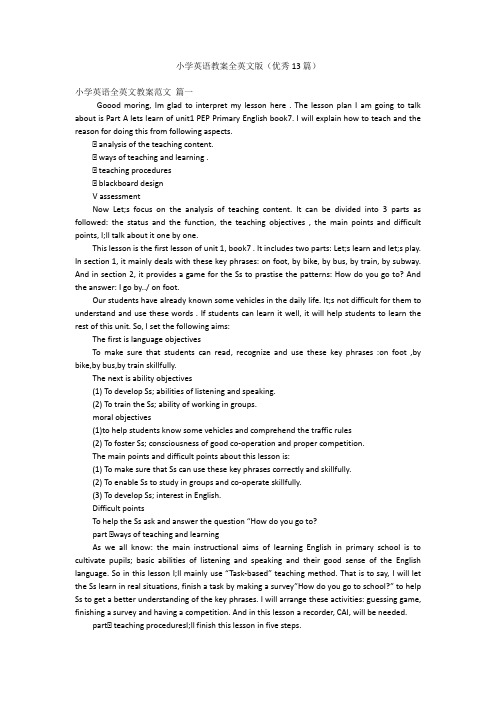
小学英语教案全英文版(优秀13篇)小学英语全英文教案范文篇一Goood moring, Im glad to interpret my lesson here . The lesson plan I am going to talk about is Part A lets learn of unit1 PEP Primary English book7. I will explain how to teach and the reason for doing this from following aspects.Ⅰ analysis of the teaching content.Ⅰ ways of teaching and learning .Ⅰ teaching proceduresⅠ blackboard designV assessmentNow Let;s focus on the analysis of teaching content. It can be divided into 3 parts as followed: the status and the function, the teaching objectives , the main points and difficult points, I;ll talk about it one by one.This lesson is the first lesson of unit 1, book7 . It includes two parts: Let;s learn and let;s play. In section 1, it mainly deals with these key phrases: on foot, by bike, by bus, by train, by subway. And in section 2, it provides a game for the Ss to prastise the patterns: How do you go to? And the answer: I go by../ on foot.Our students have already known some vehicles in the daily life. It;s not difficult for them to understand and use these words . If students can learn it well, it will help students to learn the rest of this unit. So, I set the following aims:The first is language objectivesTo make sure that students can read, recognize and use these key phrases :on foot ,by bike,by bus,by train skillfully.The next is ability objectives(1) To develop Ss; abilities of listening and speaking.(2) To train the Ss; ability of working in groups.moral objectives(1)to help students know some vehicles and comprehend the traffic rules(2) To foster Ss; consciousness of good co-operation and proper competition.The main points and difficult points about this lesson is:(1) To make sure that Ss can use these key phrases correctly and skillfully.(2) To enable Ss to study in groups and co-operate skillfully.(3) To develop Ss; interest in English.Difficult pointsTo help the Ss ask and answer the question “How do you go to?part Ⅰways of teaching and learningAs we all know: the main instructional aims of learning English in primary school is to cultivate pupils; basic abilities of listening and speaking and their good sense of the English language. So in this lesson I;ll mainly use “Task-based” teaching method. That is to say, I will let the Ss learn in real situations, finish a task by making a survey”How do you go to school?” to help Ss to get a better understanding of the key phrases. I will arrange these activities: guessing game, finishing a survey and having a competition. And in this lesson a recorder, CAI, will be needed.partⅠ teaching proceduresI;ll finish this lesson in five steps.step1 lead--in activitiesI will begin my class with drawing and guessing game, just like this : I show students some vehicles such as bike ,bus ,jeep which they learned before by Stick Figures and ask them guess what;s it.Purpose: It is important to form a better English learning surrounding for the Ss by guessing game. and at the same time it provides situations to review learned knowledge for the next step.step2 prestentationNow I;ll mainly talk about this step.1、first there is a Free talk between T and Ss. For example: I show many pictures of beautiful cities and ask students some questions, such as do you like this city?where do you want to go ?and help Ss to answer them with by train ,by plane,by ship.By the way, I show the picture of a school, and say“ I go to schiool by bus” ,Ss read this sentence. do the actions and ask how do you go to school?,show many pictures of tools such as ,on foot by bike ,by bus to help students answer my question one by one.To present the key structures one by one is much easier for the Ss to learn and grasp the meanings.2 With the help of the CAI I set a situation to help Ss understand the way of using these key phrases:A boy is coming, who is going to school. He says: I go to school byThen play the sounds of bus, bike ask students to listen carefully and tell “I go to school by according to the different sounds, by the way , I present another new phrases:by subwayPurpose:Make Ss use these new phrases with sentence structures, to help Ss use the language in a real situation.step3 practise3 I order to make every student read these new phrases correctly, I design a drill in this step,I show cards as soon as possible ,students should read the words quickly and spell them. Then I ask How do you go to school?students answer I go to ......also I will quicken the speed to ask .The purpose is to draw the whole studentsattention to the spelling of the words4 After this, I ask Ss to do Lets play in fours. They use places cards and vehicle cards, ask and answer:How do you go to ? I go to by”5, If Ss can ask and answer expertly, I will ask them to make a short dialogue.the purpose of this is to help students to learn those sentenses through a ture situation and make the dialogues in order to check if Ss can usse these key prases、sentences structures skillfullystep 4 consolidationlet students do a survey about how do you go to school?and the table like this :write down names and tools another Ss chooseTask-based teaching method is used here to develop Ss; ability of ; communication and also their ability of co-operation will be well trained.step 5 homeworkask students to collect other kinds of transport tools through the library ,computer.the purpose of this is to stimulate the interest of learning english and to wide the studentsknowledgestep6 blackboard designmy blackboard design like this :on the left Ishow the phrases:on foot,by bus.......on the right there are many sentences:how do you go to school?I go to ......step 7 assessmentdue to the studentsage ,I make every students work in class through many activities in order to stimulate the studentsinterest and provide they a wide thinking room. I make students learn this lesson very well through desiring scene statuesthats all,thank you for your listening !Unit 1 Lesson 篇二Part A Let;s say, Let;s chant Part C CultureTeaching Aims :1、Be able to listen, say, recognize the words: apple, ant, boy, bag, Coke, coffee.2、Be able to listen, say, read and write these three letters: A a; B b; C c3、Through the chant review the letters of ABC, train a sense of group identity.Focus Points amp; Difficult Points :Read the letters: Big letter C, small letter c; Write down them correctly and handsomely.Teaching Preparation:1、Letter cards ,some word pictures, word cards: apple boy eraser ant crayon body head cake Coke coffee bag ball2、A little blackboard with four-line format and a ball.Designing for the blackboard:panda beaver eagle kangaroo (pictures)China Canada America Australia (words)Teaching Steps:Step1. Warm ndash;up1、Sing a song.2、Free talkT: Hello. I;m Wendy. I;m from Hangzhou.S1: Hello! I;m 。
小学英语全英文教案范文

小学英语全英文教案范文一、Lesson OverviewIn this lesson, students will learn about dly routines and the use of present tense. Through a fun and engaging story, students will practice listening, speaking, reading, and writing skills. They will also learn to describe their dly routines using simple sentences in the present tense. Objectives:To introduce and practice the present tense.To describe dly routines using simple sentences.To enhance listening, speaking, reading, and writing skills. Materials:Storybook: "My Dly Routine"Flashcards of dly routinesWorksheet: "My Dly Routine"Whiteboard and markers二、Preparation1. Prepare the classroom setting up the necessary materials.2. Display the flashcards of dly routines around the classroom.3. Make a copy of the worksheet "My Dly Routine" for each student.三、Introduction1. Begin the class with a warm-up activity. Ask students questions about their dly routines and elicit responses using the present tense. Forexample: "What time do you get up?", "What do you have for breakfast?" etc.2. Introduce the storybook "My Dly Routine" and read it aloud to the students. Encourage them to follow along and repeat the words and phrases they hear.四、Practice1. After reading the storybook, ask students to identify the different dly routines mentioned in the story. Display the flashcards and elicit responses from the students.2. Divide the class into small groups and give each group a worksheet. Instruct them to plete the worksheet writing their own dly routines in the present tense.3. Conduct a group activity where students take turns sharing their pleted worksheets with the class. Encourage them to ask questions and provide feedback.五、Closure1. Summarize the mn points of the lesson recapping the dly routines and the use of present tense.2. Ask students if they have any questions or concerns about the lesson.3. Assign a homework task where students write a short paragraph describing their dly routines using the present tense.Note: This is just a sample lesson plan for the first five chapters. You cancontinue with more chapters and activities based on your requirements.六、Lesson OverviewIn this lesson, students will learn about family members and the use of possessive pronouns. Through a fun and engaging activity, students will practice recognizing and using possessive pronouns correctly. They will also learn to describe their family members and their belongings using possessive pronouns.Objectives:To introduce and practice possessive pronouns.To describe family members and their belongings using possessive pronouns.To enhance listening, speaking, reading, and writing skills. Materials:Flashcards of family membersWorksheet: "My Family"Whiteboard and markers七、Preparation1. Prepare the classroom setting up the necessary materials.2. Display the flashcards of family members around the classroom.3. Make a copy of the worksheet "My Family" for each student.八、Introduction1. Begin the class with a warm-up activity. Ask students questions abouttheir family members and elicit responses using possessive pronouns. For example: "Who is your mother?", "What does your father do?" etc.2. Introduce the concept of possessive pronouns and expln how they are used to show ownership. Use examples and provide clarification if needed.九、Practice1. Divide the class into small groups and give each group a worksheet. Instruct them to plete the worksheet writing sentences about their family members and their belongings using possessive pronouns.2. Conduct a group activity where students take turns sharing their pleted worksheets with the class. Encourage them to ask questions and provide feedback.十、Closure1. Summarize the mn points of the lesson recapping the family members and the use of possessive pronouns.2. Ask students if they have any questions or concerns about the lesson.3. Assign a homework task where students write a short paragraph describing their family members and their belongings using possessive pronouns.Note: This is just a sample lesson plan for the remning five chapters. You can continue with more chapters and activities based on your requirements.重点和难点解析本文主要介绍了两个主题:日常活动和家庭成员。
- 1、下载文档前请自行甄别文档内容的完整性,平台不提供额外的编辑、内容补充、找答案等附加服务。
- 2、"仅部分预览"的文档,不可在线预览部分如存在完整性等问题,可反馈申请退款(可完整预览的文档不适用该条件!)。
- 3、如文档侵犯您的权益,请联系客服反馈,我们会尽快为您处理(人工客服工作时间:9:00-18:30)。
Instructional Design
I. Background information
Content: Section A, Unit 5, JEFC
Teacher: Chen Jie
Description of students: 40 students in Junior/Primary/Senior 1, 15 boys and 25 girls Lesson duration: 40 minutes
Time & date: 8:20—9:00am, Tuesday, 29th April, 2014
II. Teaching contents:
Topic: Asking the way.
New words: face, hand, ….
New patterns: Could you tell me how to get to the post office?
按照听、读、说、写的内容分开写,然后要功能与话题。
III. Teaching key points and difficulties:
Teaching key points:
Teaching difficulties:
IV. Teaching objectives:
A.Knowledge objectives
By the end of the lesson, students should be able to: ……
B.Ability objectives
By the end of the lesson, students should be able to ……
C.Affects/Morality/Attitude….
Students learn to be good listeners while the others are talking.
V. Teaching aids:
tapes, OHP, chalk, etc.
VI. Teaching Model /Method
•PPP
•Three stages
•Five-step teaching method
•Audio-lingual method, etc.
•语法课见第七单元
•每节课选用一个
VII. The style of the lesson:
•Reading
•Reading and writing
•Reading and talking
•Listening and talking
•Listening and speaking
•Grammar
•Exercises
VIII. Teaching procedure(s):要分配时间到每一步,总共四十分钟
Step 1. Lead-in/Warm-up/Revision
Step 2. Presentation
Step 3. Practice/Pair work, etc
Step 4. Production
Step 5. Consolidation/Feedback
Step 6. Summary
Step 7. Homework
以上每步不超过八分钟,呈现新内容不超过五分钟,而且中间可以灵活增加。
每一步都要说明设计意图,原因,师生双方的活动内容。
IX. Reflection:
(To be done after class.)
X. Blackboard design’。
